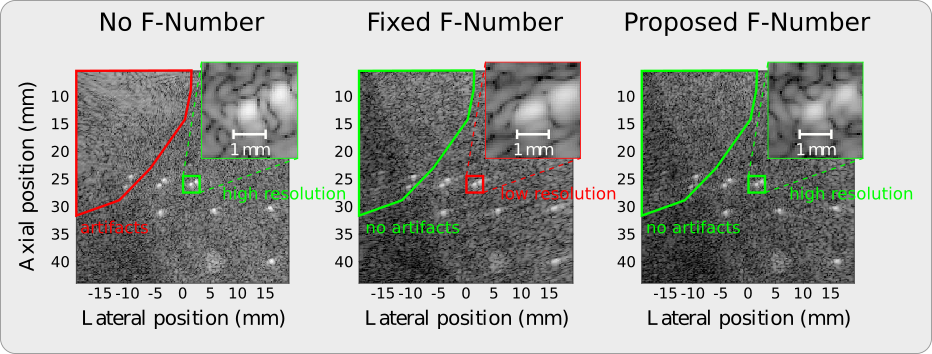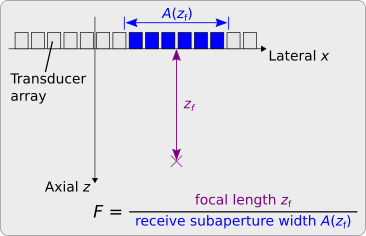Frequency-Dependent F-Number for Coherent Plane-Wave Compounding
Simple MATLAB implementation of the frequency-dependent F-number [1] for coherent plane-wave compounding.
What is an F-Number?
The F-number significantly reduces image artifacts in all image formation methods using the delay-and-sum (DAS) algorithm, such as
The F-number, for a uniform linear transducer array, equals the quotient of the focal length and the width of the receive subaperture.
The usage of a fixed F-number results in a dynamic receive subaperture whose width increases with the focal length.
Established Methods to Compute the F-Number are Contradictory and Yield Frequency-Dependent Results
Established methods to compute the optimal F-number attribute the image artifacts to two different phenomena:
-
Noise [4], [5], [2]: The directivity of the array elements attenuates the echoes and reduces the signal-to-noise ratio of the recorded signals.
-
Grating lobes [6], [7]: The width of the receive subaperture determines the grating lobe-to-main lobe ratio.
Both approaches, although yielding similar F-numbers (0.5 <= F <= 2), are mutually contradictory.
Wide array elements, for example, show
an increased directivity.
The "Noise" approach suggests
the usage of
narrow receive subapertures or, equivalently,
large F-numbers for
such elements to improve
the signal-to-noise ratio.
The "Grating lobes" approach, in contrast, permits
wide receive subapertures or, equivalently,
small F-numbers for
such elements because they attenuate
the grating lobes.
Both approaches, moreover, yield F-numbers that increase with the frequency.
The DAS algorithm, however, requires a fixed F-number and typically uses the maximum F-number at the upper frequency bound. This F-number satifies the conditions for all lower frequencies but, owing to its suboptimal value, reduces the spatial resolution.
What Does the Proposed F-Number Accomplish?
The proposed F-number not only eliminates image artifacts but also maintains the spatial resolution of the full aperture [1].
This F-number, in particular, prevents the first-order grating lobes from insonifying reflective image structures. The F-number, to this end, uses a closed-form expression, which derives from the far-field sensitivity of the focused receive subaperture, to impose a minimum angular distance on these grating lobes.
How Does the Implementation Work?
A Fourier-domain beamforming algorithm enables the usage of frequency-dependent F-numbers. The algorithm not only varies the width of the receive subaperture with the voxel position but also with the frequency. This additional frequency dependence, in contrast to a fixed F-number, includes additional frequency components that improve both the contrast and the spatial resolution.
| Method | Width of the receive subaperture | Spatial resolution | Grating lobe suppression |
|---|---|---|---|
| No F-number | always full | optimal | none |
| Fixed F-number | position-dependent | minimal | exaggerated |
| Proposed F-number | frequency- and position-dependent | almost optimal | optimal |
Getting Started
- Clone the repository or download the release to your local hard drive.
git clone https://github.com/mschiffn/f_number
- Add the repository to your MATLAB path using .
addpath( genpath( './f_number' ) )Folder Structure
The repository has the following structure:
.
├── +f_numbers # classes for various types of F-numbers (e.g., fixed, directivity-derived, proposed)
├── +windows # classes for various window functions (e.g., boxcar, Hann, Tukey)
├── das_pw.m # main function
├── LICENSE # license file
└── README.md # this readme
The packages +f_numbers and +windows contain an exemplary class hierarchy to manage various types of F-numbers and window functions. The proposed F-number can be instantiated by
F_number_rx = f_numbers.grating.angle_lb( 45, 3 )The directivity-derived F-number [4] is
F_number_rx = f_numbers.directivity.perrot( 0.918 )Image Formation
Use the function das_pw to form images.
In MATLAB type
help das_pwto obtain an explanation of the input and output arguments.
The typical usage is:
[ image, F_number_values ] = das_pw( positions_x, positions_z, data_RF, f_s, e_theta, element_width, element_pitch, ( 1 - N_elements ) / 2, [ f_lb, f_ub ], c_ref, N_samples_shift, window, F_number);References 📓
-
M. F. Schiffner and G. Schmitz, "Frequency-Dependent F-Number Increases the Contrast and the Spatial Resolution in Fast Pulse-Echo Ultrasound Imaging," 2021 IEEE Int. Ultrasonics Symp. (IUS), in press.
-
G. Montaldo, M. Tanter, J. Bercoff, N. Benech, and M. Fink, “Coherent plane-wave compounding for very high frame rate ultrasonography and transient elastography," IEEE Trans. Ultrason., Ferroelectr., Freq. Control, vol. 56, no. 3, pp. 489–506, Mar. 2009.
-
J. A. Jensen, S. I. Nikolov, K. L. Gammelmark, and M. H. Pedersen, “Synthetic aperture ultrasound imaging,” Ultrasonics, vol. 44, Supplement, e5–e15, Dec. 2006.
-
V. Perrot, M. Polichetti, F. Varray, and D. Garcia, “So you think you can DAS? A viewpoint on delay-and-sum beamforming,” Ultrasonics, vol. 111, p. 106 309, Mar. 2021.
-
T. L. Szabo, Diagnostic Ultrasound Imaging: Inside Out, 2nd. Elsevier Academic Press, Dec. 2013
-
B. Delannoy, R. Torguet, C. Bruneel, E. Bridoux, J. M. Rouvaen, and H. Lasota, “Acoustical image reconstruction in parallel-processing analog electronic systems,” J. Appl. Phys., vol. 50, no. 5, pp. 3153–3159, May 1979.
-
C. Bruneel, E. Bridoux, B. Delannoy, B. Nongaillard, J. M. Rouvaen, and R. Torguet, “Effect of spatial sampling on an acoustical image reconstruction,” J. Appl. Phys., vol. 49, no. 2, pp. 569–573, Feb. 1978.













